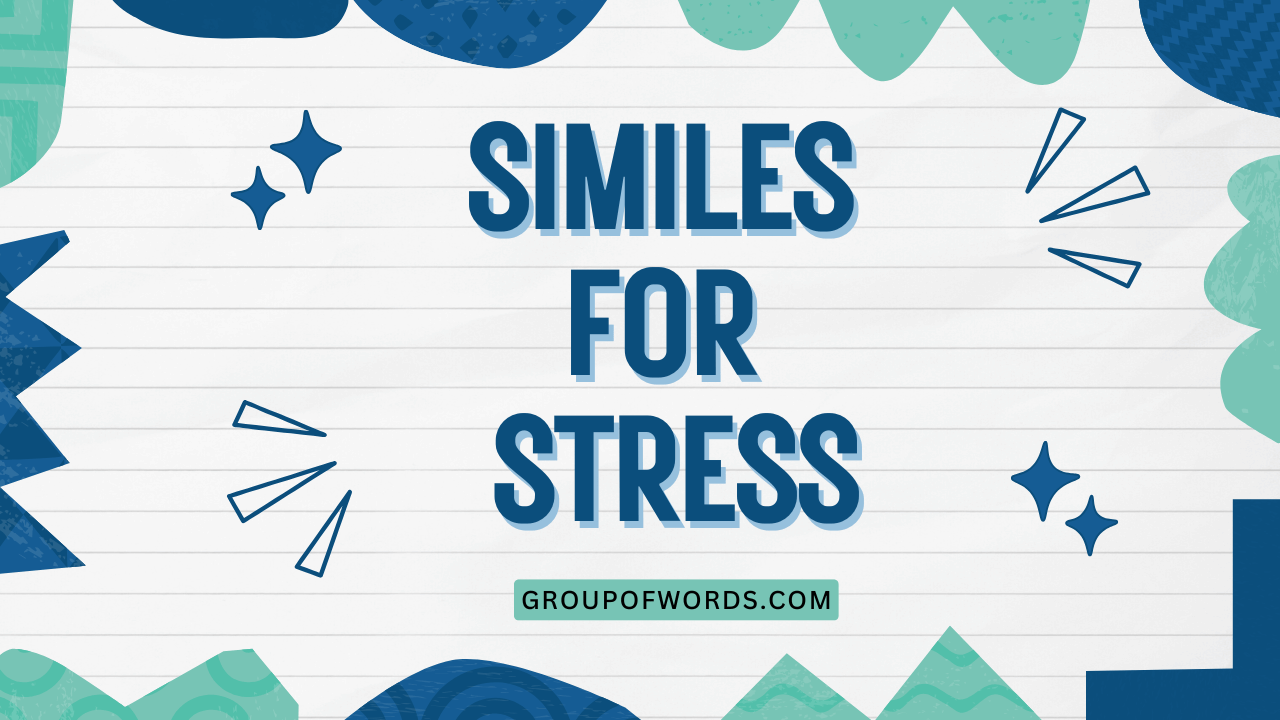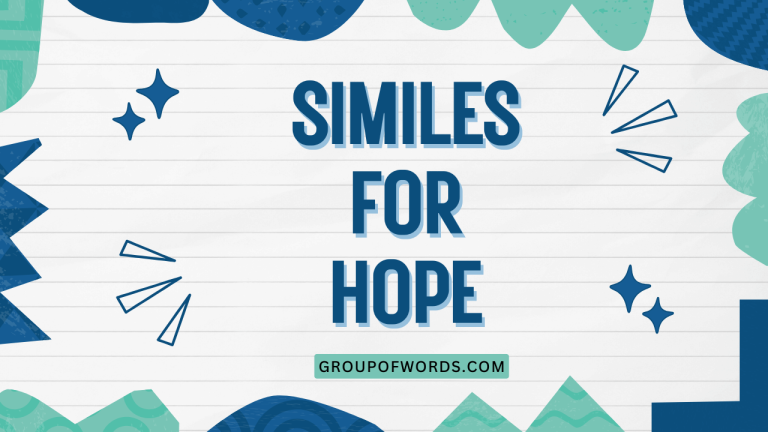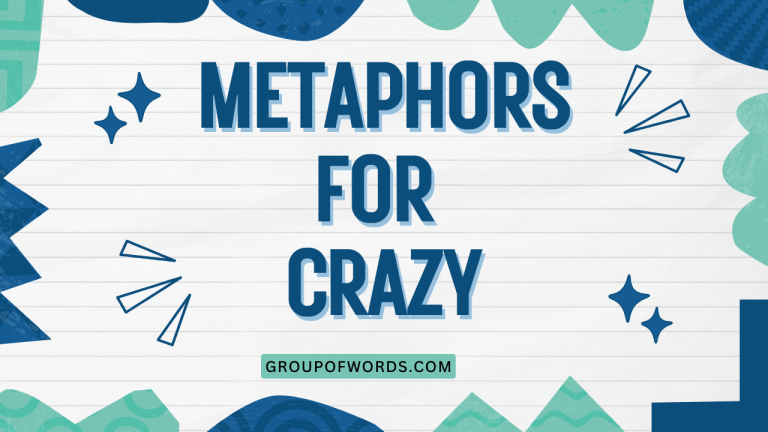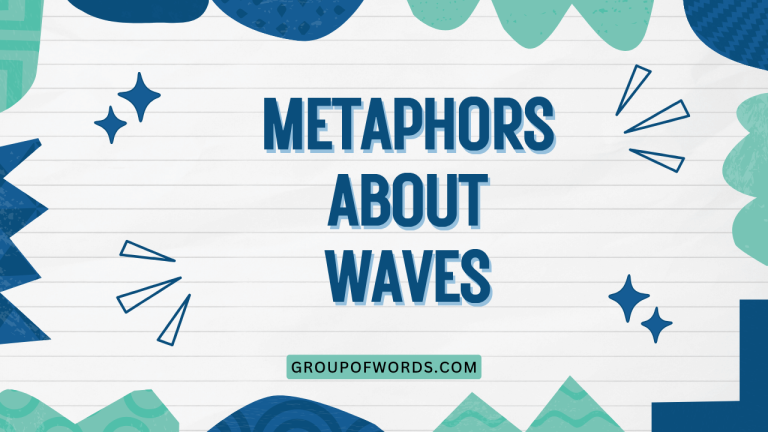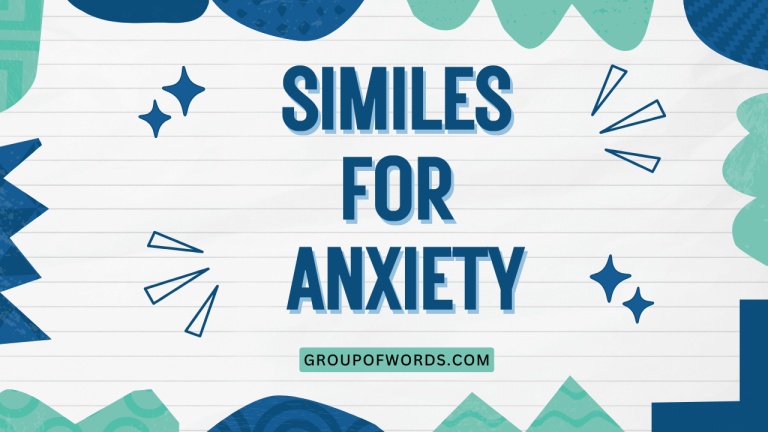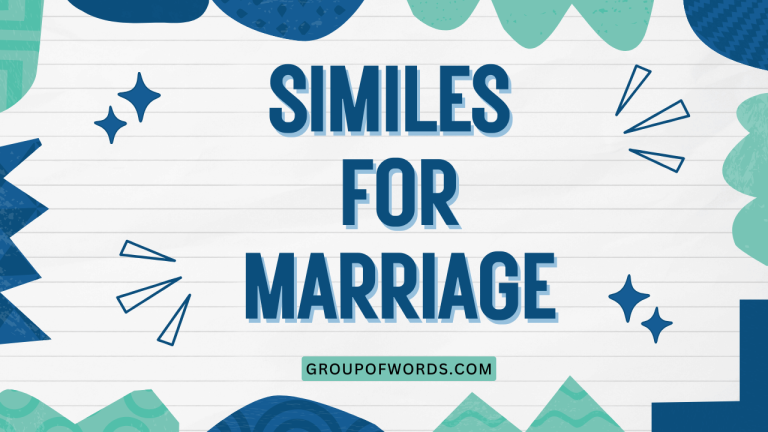Similes for Stress: A Comprehensive Guide to Expressing Anxiety
Understanding how to express stress effectively is crucial for clear communication and emotional intelligence. Similes, a powerful figure of speech, can help convey the intensity and nuances of stress in a vivid and relatable way.
This article explores the use of similes to describe stress, providing definitions, structural breakdowns, examples, usage rules, common mistakes, practice exercises, and advanced topics to help you master this expressive tool. Whether you’re an English language learner or a native speaker looking to enhance your descriptive abilities, this guide will equip you with the knowledge and skills to use similes for stress with confidence and accuracy.
By understanding and utilizing similes effectively, you can not only articulate your own feelings of stress but also empathize with others by better understanding their experiences. This article aims to provide a comprehensive overview of similes related to stress, ensuring you have a solid foundation for expressing complex emotions with clarity and impact.
Table of Contents
- Definition of Similes for Stress
- Structural Breakdown of Similes
- Types of Similes for Stress
- Examples of Similes for Stress
- Usage Rules for Similes
- Common Mistakes When Using Similes
- Practice Exercises
- Advanced Topics: Nuances and Subtleties
- Frequently Asked Questions
- Conclusion
Definition of Similes for Stress
A simile is a figure of speech that compares two unlike things using the words “like” or “as.” Its primary function is to create a vivid image or emphasize a particular quality by drawing a parallel between something familiar and something less so. In the context of stress, similes are used to describe the feeling of being stressed by comparing it to something else that evokes a similar sense of pressure, anxiety, or overwhelm.
Similes help to express the intensity and nature of stress in a more relatable and impactful way.
For instance, saying “I felt stressed” is a simple statement. However, saying “I felt as stressed as a tightrope walker without a safety net” paints a much clearer picture of the speaker’s anxiety and vulnerability.
The use of similes adds depth and emotional resonance to the description of stress.
Similes differ from metaphors in that similes use “like” or “as” to make a direct comparison, while metaphors imply the comparison without using these words. For example, a simile might be “He was as angry as a hornet,” while a metaphor would be “He was a hornet.” Both are effective, but similes provide a more explicit comparison.
Structural Breakdown of Similes
The basic structure of a simile consists of three key components: the subject (the thing being described), the connecting word (“like” or “as”), and the object of comparison (the thing it is being compared to). Understanding this structure is vital for crafting effective and clear similes.
The formula for a simile is: Subject + Connecting Word + Object of Comparison.
Let’s break down this structure with an example: “My mind was like a tangled ball of yarn.”
- Subject: My mind
- Connecting Word: like
- Object of Comparison: a tangled ball of yarn
This structure allows for endless creative possibilities. The subject is the feeling of being stressed, and the object of comparison can be anything that evokes a similar feeling, such as natural phenomena (storms, earthquakes), physical sensations (tightness, pressure), or even abstract concepts (chaos, confusion).
Another example: “She felt as anxious as a student before an exam.”
- Subject: She
- Connecting Word: as
- Object of Comparison: a student before an exam
By understanding this structure, you can create your own similes to accurately capture the nuances of stress, making your communication more powerful and relatable.
Types of Similes for Stress
Similes for stress can be categorized based on the type of comparison they make. Here are some common categories:
1. Physical Similes
These similes compare stress to physical sensations or objects. They often describe how stress feels in the body.
2. Emotional Similes
These similes compare stress to other emotions, highlighting the intensity and nature of the feeling.
3. Situational Similes
These similes compare stress to specific situations or scenarios that evoke a similar sense of pressure or anxiety.
4. Abstract Similes
These similes compare stress to abstract concepts or ideas, often used to convey the more intangible aspects of stress.
Understanding these categories can help you choose the most effective simile to describe your experience of stress.
Examples of Similes for Stress
Here are several examples of similes for stress, categorized for clarity.
Table 1: Physical Similes for Stress
This table provides examples of similes that relate stress to physical sensations, helping to convey the bodily experience of stress.
| Simile | Explanation |
|---|---|
| My head felt like it was in a vise. | Describes the feeling of intense pressure or tension in the head. |
| His muscles were as tight as guitar strings. | Conveys physical tension and stiffness due to stress. |
| She felt like her stomach was tied in knots. | Describes the feeling of anxiety and nervousness in the stomach. |
| I felt as heavy as lead. | Expresses a sense of being weighed down by stress. |
| His chest felt like it was being crushed. | Describes the sensation of pressure and tightness in the chest. |
| Her heart was pounding like a drum. | Conveys the feeling of a racing heart due to anxiety. |
| My hands were as clammy as a cold fish. | Describes the physical symptom of clammy hands caused by stress. |
| I felt like I was carrying the weight of the world on my shoulders. | Expresses the feeling of being burdened by responsibilities and stress. |
| He was shaking like a leaf. | Describes the physical trembling caused by nervousness and stress. |
| She felt as though she had a lump in her throat. | Conveys the feeling of emotional distress and difficulty speaking. |
| I felt as stiff as a board. | Describes the physical rigidity and tension caused by stress. |
| My body felt like it was buzzing with electricity. | Conveys a sense of heightened anxiety and restlessness. |
| His breathing was as shallow as a panting dog. | Describes the rapid and shallow breathing associated with anxiety. |
| She felt like her blood was boiling. | Expresses a sense of intense anger and frustration. |
| I felt as though I was walking through quicksand. | Conveys the feeling of being stuck and unable to move forward. |
| My teeth were clenched as tight as a vise grip. | Describes the physical manifestation of tension in the jaw. |
| He felt like he was walking on eggshells. | Expresses a sense of vulnerability and fear of making mistakes. |
| She felt as though she was underwater, gasping for air. | Conveys the feeling of being overwhelmed and suffocated by stress. |
| I felt as though my brain was short-circuiting. | Describes the feeling of mental overload and confusion. |
| His face was as red as a beet. | Conveys the physical symptom of facial flushing caused by stress or embarrassment. |
| She felt like her legs were made of jelly. | Expresses the feeling of weakness and instability in the legs due to anxiety. |
| I felt as though I had swallowed a stone. | Conveys the feeling of heaviness and discomfort in the stomach. |
| My skin felt as prickly as a cactus. | Describes the sensation of heightened sensitivity and irritation. |
| He felt like he was trapped in a pressure cooker. | Expresses the feeling of being under intense pressure and confinement. |
Table 2: Emotional Similes for Stress
This table provides examples of similes that compare stress to other emotions, highlighting the intensity and nature of the feeling.
| Simile | Explanation |
|---|---|
| I felt as anxious as a cat in a room full of rocking chairs. | Describes a state of extreme nervousness and apprehension. |
| He felt like he was drowning in a sea of worries. | Conveys the overwhelming feeling of being consumed by anxiety. |
| She felt as vulnerable as a newborn bird. | Expresses a sense of helplessness and exposure to danger. |
| I felt as lost as Alice in Wonderland. | Describes a feeling of disorientation and confusion. |
| He felt like he was trapped in a nightmare. | Conveys the feeling of being in a terrifying and inescapable situation. |
| She felt as helpless as a ship without a rudder. | Expresses a sense of being out of control and without direction. |
| I felt as fearful as a child in the dark. | Describes a primal fear and vulnerability. |
| He felt like he was walking through a minefield of emotions. | Conveys the feeling of navigating a dangerous and volatile emotional landscape. |
| She felt as fragile as a butterfly’s wing. | Expresses a sense of delicate vulnerability and emotional sensitivity. |
| I felt as isolated as a castaway on a desert island. | Describes a feeling of loneliness and disconnection from others. |
| He felt as overwhelmed as a student facing a mountain of homework. | Conveys the feeling of being burdened by too much to do. |
| She felt like she was carrying a ton of bricks on her back. | Expresses the feeling of being weighed down by responsibilities. |
| I felt as though my world was crumbling around me. | Describes a feeling of impending disaster and loss of control. |
| He felt like he was running a race he couldn’t win. | Conveys the feeling of being in a hopeless and unwinnable situation. |
| She felt as though she was walking a tightrope over a canyon of despair. | Expresses a feeling of precariousness and emotional danger. |
| I felt as though I was drowning in a sea of responsibilities. | Conveys the feeling of being overwhelmed by duties and obligations. |
| He felt like he was trapped in a maze with no exit. | Describes a feeling of confusion and being unable to find a solution. |
| She felt as though she was standing on the edge of a precipice. | Expresses a feeling of being on the verge of a breakdown or disaster. |
| I felt as though my heart was breaking into a million pieces. | Conveys a feeling of intense emotional pain and sorrow. |
| He felt as though he was being torn apart by conflicting emotions. | Describes a feeling of internal conflict and emotional turmoil. |
| She felt as though she was lost in a dark and endless forest. | Expresses a feeling of disorientation and hopelessness. |
| I felt as though I was trapped in a vicious cycle of stress and anxiety. | Conveys a feeling of being unable to escape a destructive pattern. |
| He felt as though he was walking through a field of thorns. | Describes a feeling of constant pain and discomfort. |
| She felt as though she was carrying a heavy burden up a steep hill. | Expresses a feeling of constant struggle and effort. |
Table 3: Situational Similes for Stress
This table provides examples of similes that compare stress to specific situations or scenarios that evoke a similar sense of pressure or anxiety.
| Simile | Explanation |
|---|---|
| I felt as stressed as a student the night before a final exam. | Describes the anxiety and pressure of impending deadlines. |
| He felt like he was navigating a war zone. | Conveys the feeling of being in a chaotic and dangerous environment. |
| She felt as pressured as a performer about to go on stage. | Expresses the anxiety and anticipation of a high-stakes situation. |
| I felt as overwhelmed as a parent with a newborn baby. | Describes the exhaustion and responsibility of caring for a dependent. |
| He felt like he was trying to juggle too many balls at once. | Conveys the feeling of being overextended and unable to manage multiple tasks. |
| She felt as trapped as a rat in a maze. | Expresses a sense of confinement and lack of control. |
| I felt as though I was walking on thin ice. | Describes a risky and precarious situation. |
| He felt as stressed as a project manager facing a tight deadline. | Conveys the pressure and responsibility of meeting project goals. |
| She felt like she was in a pressure cooker. | Expresses the feeling of being under intense and unbearable pressure. |
| I felt as though I was fighting a losing battle. | Describes a feeling of hopelessness and futility. |
| He felt as though he was lost in a bureaucratic nightmare. | Conveys the frustration and confusion of dealing with complex systems. |
| I felt as stressed as a waiter during the dinner rush. | Describes the frenzy and pressure of a busy service environment. |
| She felt like she was trying to put out fires everywhere. | Expresses the feeling of constantly dealing with urgent problems. |
| He felt as though he was stuck in a traffic jam with no escape. | Conveys the frustration and helplessness of being stuck in a bad situation. |
| I felt as though I was being interrogated under a spotlight. | Describes the feeling of being scrutinized and judged. |
| She felt like she was trapped in a never-ending meeting. | Expresses the boredom and frustration of unproductive discussions. |
| He felt as pressured as an athlete competing in the Olympics. | Conveys the high stakes and intense competition of a major event. |
| I felt as though I was walking through a haunted house. | Describes the feeling of constant fear and anticipation of something bad. |
| She felt like she was drowning in paperwork. | Expresses the feeling of being overwhelmed by administrative tasks. |
| He felt as stressed as a surgeon during a critical operation. | Conveys the pressure and responsibility of making life-or-death decisions. |
| I felt as though I was trying to climb a mountain without any gear. | Describes the feeling of attempting a difficult task without the necessary resources. |
| She felt like she was trapped in a time loop. | Expresses the feeling of being stuck in a repetitive and inescapable pattern. |
| He felt as stressed as an air traffic controller during a storm. | Conveys the pressure and responsibility of managing a complex and dangerous situation. |
| I felt as though I was trying to herd cats. | Describes the feeling of attempting to manage a group of uncooperative individuals. |
Table 4: Abstract Similes for Stress
This table provides examples of similes that compare stress to abstract concepts or ideas, often used to convey the more intangible aspects of stress.
| Simile | Explanation |
|---|---|
| I felt as chaotic as a hurricane. | Describes the feeling of being completely overwhelmed and disorganized. |
| He felt like he was unraveling at the seams. | Conveys the feeling of losing control and falling apart. |
| She felt as fragmented as a shattered mirror. | Expresses a sense of being broken and incomplete. |
| I felt as empty as a hollow shell. | Describes a feeling of emotional numbness and detachment. |
| He felt like he was fading into the background. | Conveys the feeling of losing identity and becoming invisible. |
| She felt as fragile as a house of cards. | Expresses a sense of instability and vulnerability. |
| I felt as though my mind was a battlefield. | Describes the feeling of internal conflict and mental turmoil. |
| He felt as volatile as a ticking time bomb. | Conveys the feeling of being on the verge of explosion or breakdown. |
| She felt like she was trapped in a web of obligations. | Expresses the feeling of being entangled and unable to break free. |
| I felt as though my thoughts were scattered like leaves in the wind. | Describes the feeling of mental disarray and lack of focus. |
| He felt as though he was lost in a sea of uncertainty. | Conveys the feeling of being disoriented and lacking direction. |
| She felt like she was drowning in a pool of negativity. | Expresses the feeling of being consumed by pessimistic thoughts. |
| I felt as though my energy was draining away like water through a sieve. | Describes the feeling of exhaustion and depletion. |
| He felt as though he was trapped in a vortex of anxiety. | Conveys the feeling of being sucked into a cycle of worry and fear. |
| She felt as though her inner peace was as elusive as a mirage. | Expresses the difficulty of finding tranquility and calm. |
| I felt as though I was carrying a burden of unspoken words. | Describes the weight of repressed emotions and unexpressed thoughts. |
| He felt as though he was caught in a crossfire of conflicting demands. | Conveys the feeling of being pulled in multiple directions. |
| She felt like she was walking through a fog of confusion. | Expresses the feeling of mental cloudiness and disorientation. |
| I felt as though my dreams were as distant as stars in the night sky. | Describes the feeling of unattainable goals and aspirations. |
| He felt as though he was running on a treadmill, going nowhere. | Conveys the feeling of constant effort without any progress. |
| She felt as though she was trapped in a cage of her own making. | Expresses the feeling of being confined by self-imposed limitations. |
| I felt as though my spirit was withering like a dying plant. | Describes the feeling of emotional and spiritual decline. |
| He felt as though he was adrift at sea without a compass. | Conveys the feeling of being lost and without direction in life. |
| She felt like she was trapped in a labyrinth of her own thoughts. | Expresses the feeling of being lost and confused in one’s own mind. |
Usage Rules for Similes
Using similes effectively involves adhering to certain rules to ensure clarity and impact. Here are some key rules to keep in mind:
- Clarity: Ensure the comparison is clear and easily understood. The object of comparison should be familiar enough that the reader can grasp the intended meaning.
- Relevance: The object of comparison should have a strong connection to the subject being described. The shared quality should be obvious and relevant to the context.
- Originality: While common similes can be effective, strive for originality to make your writing more engaging and memorable. Avoid clichés whenever possible.
- Context: Consider the context in which the simile is used. The appropriateness of a simile can depend on the tone and audience.
Example of a Clear Simile: “He was as nervous as a long-tailed cat in a room full of rocking chairs.” This simile is clear because the image of a cat in that situation readily conveys nervousness.
Example of a Relevant Simile: “Her anger was like a volcano erupting.” This is relevant because both anger and a volcano erupting involve a sudden and powerful release of pent-up energy.
Example of an Original Simile: Instead of saying “He was as busy as a bee,” try “He was as busy as a one-armed paper hanger.” This is more unique and attention-grabbing.
Common Mistakes When Using Similes
Even experienced writers can make mistakes when using similes. Here are some common errors to avoid:
- Using Clichés: Overused similes can make your writing sound uninspired.
- Creating Confusing Comparisons: If the comparison is too obscure or doesn’t make sense, it will confuse the reader.
- Mixing Metaphors and Similes: Be consistent with your figurative language. Don’t switch between similes and metaphors in the same sentence.
- Using Inaccurate Comparisons: Ensure that the comparison is accurate and logical.
Example of a Cliché: Incorrect: “He was as busy as a bee.” Correct: “He was as busy as a short order cook at lunchtime.”
Example of a Confusing Comparison: Incorrect: “My stress was like a purple elephant.” Correct: “My stress was like a heavy anchor, weighing me down.”
Example of Mixing Metaphors and Similes: Incorrect: “She was a whirlwind, as fast as a cheetah.” Correct: “She was as fast as a cheetah.”
Example of an Inaccurate Comparison: Incorrect: “He was as calm as a thunderstorm.” Correct: “He was as calm as a still lake.”
Practice Exercises
Test your understanding of similes for stress with these exercises.
Exercise 1: Fill in the Blanks
Complete the following sentences with appropriate similes.
| Question | Answer |
|---|---|
| 1. My anxiety felt _______________. | 1. My anxiety felt like a swarm of bees buzzing in my head. |
| 2. He was as stressed as _______________. | 2. He was as stressed as a tightrope walker without a net. |
| 3. She felt like she was drowning in _______________. | 3. She felt like she was drowning in a sea of responsibilities. |
| 4. I felt as though my mind was _______________. | 4. I felt as though my mind was a tangled ball of yarn. |
| 5. He felt as pressured as _______________. | 5. He felt as pressured as a diamond being formed. |
| 6. She felt as vulnerable as _______________. | 6. She felt as vulnerable as a newborn fawn. |
| 7. I felt as isolated as _______________. | 7. I felt as isolated as a lighthouse in a storm. |
| 8. He felt as overwhelmed as _______________. | 8. He felt as overwhelmed as a student facing a mountain of homework. |
| 9. She felt like her world was _______________. | 9. She felt like her world was crumbling around her. |
| 10. I felt as though I was _______________. | 10. I felt as though I was walking through quicksand. |
Exercise 2: Identify the Simile
Identify the simile in each sentence.
| Question | Answer |
|---|---|
| 1. His anger was like a raging fire. | 1. like a raging fire |
| 2. She felt as trapped as a bird in a cage. | 2. as trapped as a bird in a cage |
| 3. My stress was as heavy as a ton of bricks. | 3. as heavy as a ton of bricks |
| 4. He felt like he was walking on eggshells. | 4. like he was walking on eggshells |
| 5. Her anxiety was as sharp as a knife. | 5. as sharp as a knife |
| 6. I felt like I was drowning in paperwork. | 6. like I was drowning in paperwork |
| 7. He was as nervous as a long-tailed cat in a room full of rocking chairs. | 7. as nervous as a long-tailed cat in a room full of rocking chairs |
| 8. She felt as though she was carrying the weight of the world on her shoulders. | 8. as though she was carrying the weight of the world on her shoulders |
| 9. His mind was as chaotic as a hurricane. | 9. as chaotic as a hurricane |
| 10. I felt like I was running a race I couldn’t win. | 10. like I was running a race I couldn’t win |
Exercise 3: Create Your Own Similes
Write a simile to describe each of the following situations:
| Situation | Example Simile |
|---|---|
| 1. Feeling overwhelmed with work | 1. I felt as overwhelmed as a conductor trying to lead five orchestras at once. |
| 2. Experiencing intense anxiety | 2. My anxiety felt like a swarm of bees trapped in a jar, buzzing frantically. |
| 3. Feeling the pressure of a deadline | 3. The deadline loomed like a guillotine, ready to drop at any moment. |
| 4. Feeling emotionally drained | 4. I felt as emotionally drained as a well that had run dry. |
| 5. Experiencing constant stress | 5. The constant stress felt like a persistent toothache, never quite going away. |
| 6. Feeling mentally exhausted | 6. My mind felt as exhausted as a computer running too many programs at once. |
| 7. Feeling trapped in a difficult situation | 7. I felt as trapped as a fly caught in a spider’s web. |
| 8. Feeling the weight of responsibility | 8. The weight of responsibility felt like carrying a mountain on my back. |
| 9. Feeling lost and confused | 9. I felt as lost and confused as a tourist in a foreign city without a map. |
| 10. Feeling on the verge of a breakdown | 10. I felt as though I was standing on the edge of a cliff, ready to fall. |
Advanced Topics: Nuances and Subtleties
For advanced learners, mastering the nuances and subtleties of similes can elevate their writing to a new level. This involves understanding how to use similes in a way that is both creative and precise.
1. Layered Similes: Combining multiple similes to create a more complex and nuanced description.
Example: “Her stress was like a tangled web, each strand representing a different worry, pulling tighter and tighter until she felt as trapped as a fly caught in its sticky threads.”
2. Subverted Similes: Using similes in an unexpected or ironic way to create a surprising effect.
Example: “He was as calm as a bomb disposal expert, right before the bomb went off.”
3. Cultural and Contextual Sensitivity: Understanding how cultural background and context can influence the interpretation of similes.
Example: A simile that references a specific cultural event or object might not be understood by someone from a different background.
4. Using Similes to Create Tone and Mood: Choosing similes that evoke specific emotions and contribute to the overall tone of the writing.
Example: Using dark and foreboding similes to create a sense of unease and suspense.
Frequently Asked Questions
Here are some frequently asked questions about using similes for stress.
- What is the difference between a simile and a metaphor?
A simile is a comparison using “like” or “as,” while a metaphor is an implied comparison without using these words. For example, “He is like a lion” (simile) vs. “He is a lion” (metaphor). Similes make a direct comparison; metaphors suggest a resemblance.
- How can I avoid using clichés in my similes?
To avoid clichés, try to think of original and specific comparisons. Instead of “as busy as a bee,” think of a more unique image that conveys the same level of busyness, such as “as busy as a short-order cook during the lunch rush.” The key is to be creative and think outside the box.
- What makes a simile effective?
An effective simile is clear, relevant, and original. It should create a vivid image in the reader’s mind and accurately convey the intended meaning. The object of comparison should be something the reader can easily relate to and understand.
- Can I use similes in formal writing?
While similes are often used in creative writing, they can also be used in formal writing if they enhance clarity and understanding. However, it’s important to use them sparingly and ensure they are appropriate for the tone and audience.
- How can I improve my ability to create effective similes?
Practice is key. Pay attention to the similes you encounter in literature and everyday conversations. Try to come up with your own similes to describe different situations and emotions. The more you practice, the better you will become at crafting effective and original similes.
- What if my simile is misunderstood?
If your simile is misunderstood, it may be too obscure or confusing. Try to choose a more familiar and relevant object of comparison. Also, consider providing additional context to help the reader understand the intended meaning.
- Are there any cultures where similes are not commonly used?
While figurative language exists in most cultures, the specific types and frequency of use may vary. Some cultures may prefer more direct communication styles, while others may embrace figurative language more readily. It’s important to be aware of cultural differences when using similes in cross-cultural communication.
- How can I ensure my similes are culturally sensitive?
Research and understand the cultural background of your audience. Avoid using similes that rely on stereotypes or that may be offensive or insensitive. When in doubt, choose more universal and neutral comparisons.
Conclusion
Mastering similes for stress is a valuable skill that can significantly enhance your ability to communicate effectively and empathetically. By understanding the structure, types, and usage rules of similes, you can create vivid and relatable descriptions of the complex emotions associated with stress.
Avoiding common mistakes and practicing regularly will further refine your skills and allow you to express yourself with greater clarity and impact.
Remember that the key to effective simile usage lies in clarity, relevance, and originality. Strive to choose comparisons that are easily understood, strongly connected to the subject, and creatively expressed.
By incorporating these principles into your writing and speech, you can unlock the full potential of similes to convey the
depth and intensity of human emotions, fostering deeper connections and understanding.
Continue to explore and experiment with similes in your daily communication, and you’ll find that your ability to articulate complex feelings, like stress, will become increasingly refined and impactful. Embrace the power of figurative language, and let your words resonate with authenticity and emotional intelligence.
